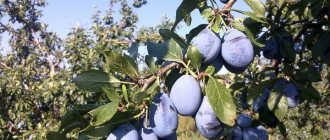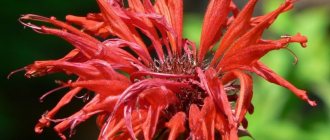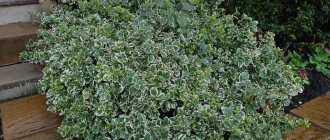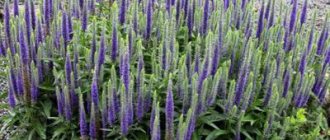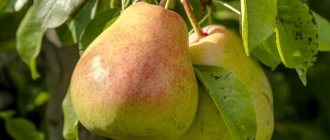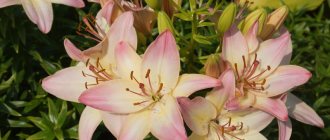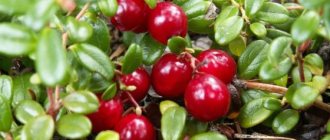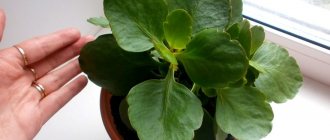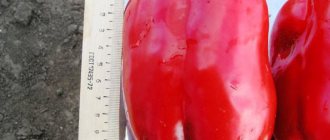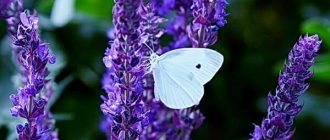Goldenrod, solidago or rose officinalis is a type of herb from the family Asteraceae or Compositae, called “solidus” in Latin, which means “strong”. Solidago grows in the form of a dense bush and produces paniculate inflorescences, reminiscent of March mimosa in color and shape.
This plant is often found in garden plots and is valued for its decorative properties. Flowers are collected for winter bouquets; they last as well as dried flowers. They are used as plant raw materials for the preparation of potions according to folk recipes.
Description of the plant
Goldenrod is a perennial cystic rhizomatous herbaceous plant. The elongated, oblong, strong root of the plant goes deep into the ground. On the surface one can see a low-branched simple shoot, up to 100 cm high. The satiny bark covers the straight stem of the goldenrod. It can be emerald or crimson in color.
The bright green leaves of the goldenrod herb are oval or ovoid in shape, with fine serrations along the edges, and saw-tooth. The lower narrow leaves are more elongated than the upper ones. The narrow leaves of goldenrod resemble the shape of willow leaves.
Common goldenrod blooms from May to September. The inflorescences consist of bell-shaped buds, lemon-colored. The length of the flowers reaches 8 mm. Bells with lemon-colored petals grow along the edges, and in the center they are distinguished by a chestnut-yellow color. The fruit formed after pollination is an achene, shaped like a cylinder with longitudinal ribs, up to 4 mm long.
Goldenrod grass is an aggressor plant: one specimen produces up to 100 thousand seeds, germination rate is 95%. In a year it can move tens of kilometers and is the rightful owner of the territories where it has settled.
Goldenrod is used in many industries. Used in veterinary medicine as an astringent. Industrially, yellow and brown paints are extracted from goldenrod. The goldenrod plant is highly valued for its beneficial properties and is used in folk medicine.
Botanical characteristics of goldenrod
Goldenrod is an exceptional perennial plant. It has a straight, strong stem up to 1 m high, longitudinal in shape, of uniform thickness, crowned with a luxurious cluster of golden flowers. Lemon-colored flowers have a delicate delicate aroma. Inflorescences are baskets. Goldenrod has alternate leaves and strong branching. Blooms from late summer to October. The goldenrod fruit is an achene shaped like a cylinder, approximately 3 mm long. Uninformed people sometimes confuse goldenrod with garden mimosa.
Botanical characteristics
The botanical name of the goldenrod plant is solidus, which is translated from Latin as “healthy,” which is very symbolic. People also call it the golden rod, apparently because of the long, flexible stems up to 1 m high, which resemble twigs. According to the “family” classification, common goldenrod belongs to the Asteraceae. About twenty of its species grow in the fields of Russia. The plant has chosen the European part of the country with the exception of the northern regions.
Although common goldenrod is an unpretentious plant, it can more often be found in sunny meadows and wastelands. The golden rod bush is decorated with small, oblong leaves that evenly cover all the stems. Clusters of juicy yellow inflorescences appear closer to the top. Flower baskets faintly emit a slightly tart aroma.
Yellow tassels of inflorescences often become decorations for field bouquets. When dried (if drying proceeds with the inflorescences facing down), they retain their volume for a long time and serve as the basis for ikebana. Thanks to its late flowering, goldenrod has become a real “gift” for beekeepers. The collection of its nectar by striped workers ends the entire season and helps to increase the productivity of the queens, which falls during this period.
Types and varieties of goldenrod
More than 100 types of culture are known. Tall specimens can reach a height of up to 2 meters. There are dwarf varieties, no more than 40 centimeters in size. Let's look at several types in more detail.
Goldenrod
Goldenrod
Common goldenrod or goldenrod (Solidago virgaurea) is the best known species.
A perennial, low-growing herbaceous plant with a short, thick, hard rhizome. The stems are straight, up to 1 meter tall, usually unbranched, with leaves. Goldenrod leaves are ovoid, pointed, with notches along the edge. Compared to the narrow lower leaves, the upper ones are smaller. The flowers are tubular, lemon-colored, the inflorescence has the shape of a brush or panicle, consisting of tiny (up to 15 mm) baskets. The fruits are uneven, cylindrical achenes with a brown tuft and are carried by the wind. Flowering occurs at the end of summer.
Lives in the vast expanses of Eurasia. Prefers illuminated prairies, mountain forests, clearings, and places near water bodies. The composition of goldenrod soil is medium, consisting of clay, silt, with an admixture of sand of various grain sizes. In Eastern Siberia and the Far East, closely related species grow - goldenrod (Solidago dahurica) and goldenrod (Solidago decurrens). They are similar to the main type in terms of the chemical composition of their components and are used in the field of medicine. Excellent honey plants.
Not only goldenrod, specially grown on the site, is harvested, but also wild-growing ones. The upper part of the branches with inflorescences is cut off, the raw materials are sorted, then dried. The grass is dried both in natural and artificial conditions.
Natural drying is carried out on a clear day in the open air, on pallets. At night, the grass is removed indoors or under the roof.
Hammocks made of gauze are sometimes hung to dry goldenrod. This method helps to ventilate the raw material from all sides, which speeds up the drying process. The grass is periodically turned over to dry evenly. The gas stove oven is also great for drying. The only thing is that you need to control the temperature in the oven to avoid burning the raw materials. The oven door must be opened.
Special universal dryers are also used. When drying, the rod is protected from bright sunlight, otherwise the raw material may change color, burn out, or lose its natural color.
The grass prefers dry places. Neutral soil is optimal for its growth. To independently determine the soil reaction, you can purchase test sticks and mini-laboratories, the handling of which does not require knowledge of the science of chemistry.
In addition, there are electronic soil measuring instruments in which the measured value is simply read on a scale. Anyone who wants to have information about the deficiency or excess of certain nutrients in the soil of his garden can take samples from various areas and send them to a special laboratory. In the garden, too acidic soils can be brought closer to neutral by adding carbonated lime. High lime content can be reduced by adding manure or compost, as well as peat replacement products.
If we talk about goldenrod varieties, then the Josephine (Aelita) variety is popular, growing up to 70 cm in height. The conspicuous goldenrod is a dense bush, with tiny lemon-colored flowers in large, exquisite inflorescences. The plant is decorative, blooms for a long time, looks amazing as part of hedges, group ensembles in mixed flower beds.
Cut flowers are wonderful in winter bouquets. Plants planted in large groups create a beautiful warm yellow color and smell pleasant. It is important not to allow the plants to seed freely, otherwise they will begin to actively grow.
Cutler's goldenrod (Solidago cutlieri)
Cutler's goldenrod (Solidago cutlieri)
There are many known synonyms of Cutler's Goldenrod: S. brachystachys, S. virgaurea, var. alpina. The plant lives in the northeastern United States. The height of the crop reaches 25 cm. The leaves are oval, up to 15 cm long, rough, with fine jagged edges. There are few leaves on the stem, they are small. The inflorescence is very short, amber-yellow, corymbose or racemose.
It blooms from September and is fragrant until frost.
This species was one of the ancestors in the development of low-growing varieties. Common and widely known varieties: “Robusta” (Robusta) up to 30 cm high, “Pyramidalis” (Pyramidalis), growing up to 50 cm. Planted in groups on the lawn, in rockeries, as a border along paths. Combines in joint plantings with fighters, larkspur, and various cereals.
Goldenrod highest
Goldenrod highest
The tallest or giant goldenrod has shoots up to 2 m in height. They form harmonious, elegant thickets, shrouded in bright emerald foliage. The inflorescences are saffron-colored, up to 40 cm long. Flowering begins in the first half of August and lasts until October.
Hybrid goldenrod
Hybrid goldenrod became the ancestor of a huge number of ornamental varieties. The plants are small in size and have luxurious foliage. The variety is very interesting to professional flower growers and simply lovers of beautiful flowers. The following varieties are known.
Dzintra
“Dzintra”
The variety was obtained before 1960. It grows in large quantities in temperate regions of the Eurasian continent. A lot of time passes from the beginning of the appearance of buds to flowering. Representatives of this variety delight with flowers for about 45 days, starting from the second half of July. All this time the plant does not lose its beauty and decorativeness.
The bush is strong, up to 60 cm high. The shoots are thick, dark green, with many leaves. The leaves are malachite, glossy, narrow, oval in shape. The inflorescence is umbrella-shaped, dense, golden in color. When the flowering process comes to an end, the ground part is cut off and colorful shoots grow again until autumn.
Goldjunge
The most fragrant of all known varieties. Height up to 120 cm, stems graceful and strong. The leaves are gray on the underside, narrow, the middle part is elongated. The edges are smooth. The inflorescence is in the shape of a panicle, up to 40 cm long, golden yellow, quite dense, the branches are gracefully bent. The baskets are tiny, the reed flowers are poorly developed. Blooms in late summer. The variety is resistant to powdery mildew.
Goldtanne
Tall and late variety of goldenrod. The stems reach a height of 2 m, light green, quite dense and strong. The leaves are narrow, pointed, bluish-green, with clearly visible veins, and there are few small serrations along the edges. The inflorescence is a large panicle up to 50 cm long, quite dense, with elegantly bent branches.
At first, the flowers are yellow, straw-colored, since the color of reed flowers dominates in the basket, later - amber-yellow, since the color of tubular flowers predominates. The value of this variety lies in its late flowering (second half of September), height and strength of peduncles.
Golden Dwarf (Solidago hybrida Golden Dwarf)
“Golden Dwarf” (Solidago hybrida Golden Dwarf)
The plant Goldenrod hybrid Golden Dwof is characterized by a bush height of up to 60 cm. The inflorescence is about 17 cm long, the flowers are saffron-colored. Flowering time is August. The variety can be safely grown both in open sunny places and in partial shade. If we talk about soil, specimens of this variety feel better on heavy, moist soils. Plants are planted in flower beds in the background or in separate groups. Look great in autumn bouquets.
Perkeo
An early variety, widely known in cultivation until 1945. The bush is up to 60 cm high and has the shape of a cone. The shoots are graceful, strong, pistachio-like. There are quite a lot of leaves, their length reaches 7 cm, width up to 1.3 cm. The leaves are light emerald, narrow, pointed, smooth, there are few small jagged edges, the underside is covered with villi. Inflorescences are up to 17 cm long, up to 20 cm wide. They form narrow bright racemes, small baskets, with well-developed reed golden-yellow flowers.
The flowering period begins in July and lasts about 40 days. The variety is actively used by gardeners in creating green plantings and is loved by florists.
Pillare
A late variety, the bush is up to 90 cm high, has the shape of a column. The shoots are dense, strong, malachite, with many leaves. The leaves are olive-green, oval-shaped, pointed, with few small jagged edges. The inflorescence is a straight, narrow, short panicle, up to 15 cm long, up to 5 cm wide. Reed flowers are poorly developed, golden-yellow tubular ones dominate. It blooms for 40 days, starting in the second half of August.
Goldenrod wrinkled
Goldenrod wrinkled
Goldenrod rugosa 'Fireworks' is a perennial up to 120 cm tall, with densely leafy, straight and strong stems. The leaves are simple oval, with fine jagged edges, pointed. Tiny inflorescences-baskets in long arched racemes are collected in a panicle shaped like a pyramid. Blooms from September.
Wrinkled goldenrod grows well in full sun, in slightly acidic, moderately moist or moist, well-drained loams. Used in group plantings on lawns or as a solo plant in flower beds of various types.
Goldenrod
Goldenrod
Canadian goldenrod lives in the foothills of North America and Eurasia and resembles common goldenrod. Usually forms thickets. In Poland, China and other countries, the spread of goldenrod is considered a national disaster, since it is capable of rapidly capturing new lands.
The stems are straight, large, up to 150 cm high. The stems branch in the upper part, are strong and hard at the base, and have many leaves along the entire length. The stems are colored in dark green and light green shades. The upper part of the shoot and leaves are abundantly covered with short fibers. The leaves are wide, with serrated edges, up to 15 cm long. The leaves are alternate, having an oblong blade with a pointed apex and base, with noticeable three veins. The lower leaves have fine serrations along the edges, the petioles are short, up to 12 cm long. The upper leaves are entire, sessile, up to 8 cm long.
It blooms in August-September with narrow lemon-colored inflorescences. Flower baskets are small, up to 5 mm in diameter. Reed flowers of lemon color are arranged in one row. The fruit is an uneven achene, shaped like a cylinder, about 15 mm long. Achenes with a brownish tuft, sticking to clothing.
Canadian goldenrod (Solidago canadensis L.) is an ornamental plant, but often runs wild. Wild plants are found in all regions of Russia. Goldenrod roots produce inhibitors, substances that inhibit the growth of other plants. There is a variety of garden forms, which differ greatly in the height and shape of the inflorescences.
Canadian goldenrod is not picky about soils, but it develops faster in relatively heavy, rich soils with average moisture. The application of mineral fertilizers (superphosphate and potassium salt) is beneficial for the plant. During flowering, abundant watering is needed, but an excess of water will cause rotting of the plant's roots and, accordingly, its death.
It develops and blooms well in sunny open areas, but can also tolerate light shading. Very winter hardy. Before winter, it is necessary to trim the ground part at a height of up to 15 cm. Tolerates partial shading, but develops better in sunny areas. The plant is very strong, large, powerful. Based on this, you should choose a spacious place for planting it.
Also, this tall plant with yellow shaggy flower panicles very quickly takes over the territory, so in small gardens it must be handled carefully. Once planted and confined to a path dug in with plastic or metal tape, you will always have an effortless supply of yellow in the garden. It is not for nothing that the popular name of this plant is associated with gold: its color is really quite noble, giving the bouquet openwork and charm.
A popular variety is Goldenrod Canadian Patio ('Patio'). The plant is up to 40 cm in height, pleases with abundant and long-lasting flowering, the flowers are small, lemon-yellow.
Goldenrod bicolor
Goldenrod (Solidago bicolor). Surprising with two-color inflorescences. Grows in North America. Plants are 120 cm high, the stems are pubescent, grayish-green. The leaves are lanceolate or elliptic, toothed or serrated, up to 15 cm long, decreasing upward along the stem.
Flower baskets are collected in a panicle, the reed flowers are snow-white or creamy-white, tubular. Not widely distributed.
Blue-gray goldenrod (Solidago caesia)
Blue-gray goldenrod (Solidago caesia)
It grows mainly in North America. Morphologically noticeably different from other species. The stems are dark green or brown, up to 120 cm long, graceful, glabrous, there are few branches, there are leaves only in the upper part of the stem. The leaves are dark emerald sessile, lanceolate, toothed or serrated, similar to willow leaves. The inflorescences are collected in a sparse cluster, reminiscent of an elegant necklace. Blooms in late autumn and blooms until winter.
Medicinal goldenrod
Canadian goldenrod has important, from a medical point of view, healing abilities:
- decontaminate;
- relieve inflammation and pain.
In the medical field, the herb is used in many countries. Shoots, flowers and root of Canadian goldenrod are used.
Goldenrod solidago is used to treat diseases of the genitourinary and digestive systems. An extract from goldenrod inflorescences is successfully used in the treatment of inflammatory disease of the prostate gland or prostate, a purely male organ located under the bladder.
The Dahurian goldenrod plant is an active component of some drugs, such as Prostanorm, Fitolysin, Marelin. The drug Prostanorm activates the movement of fluid in the cells of the prostate gland, normalizes the volume of urine produced over a certain period of time. Effectively fights pathogenic microorganisms, having a bactericidal effect and is active against aerobic bacteria.
Marelin - used in the treatment of kidney stones, relieves spasms, and is indicated for infectious and inflammatory diseases. This remedy, based on goldenrod extract, helps remove kidney stones, helps with renal colic, and has a diuretic effect.
The drug Fitolysin is effective for infectious and inflammatory diseases accompanying urolithiasis (urolithiasis). The product has a bactericidal effect and relieves spasms.
Solidago virgaurea is a homeopathic medicine made from fresh flowers. Canadian goldenrod is used in the treatment of pyelonephritis accompanied by edema. In homeopathy, infusion of Daurian goldenrod is used for dropsy, gallstones, diseases of joints and tissues caused by metabolic disorders in the body.
A decoction of golden rod herb is recommended:
- for gargling;
- for infectious diseases of the upper respiratory tract and ENT organs;
- loosening of gums and lotions with purulent wounds;
- bone fractures.
In addition, goldenrod accelerates metabolism and is effective for diseases of the skin and soft tissues, as well as liver diseases. The Canadian goldenrod herb, unlike the common goldenrod, is not poisonous and does not contain toxic substances.
Where and how does it grow
Common goldenrod is very common throughout North Africa and Eurasia. The height of the plant is approximately 60-130 centimeters and blooms in June-August. Canadian goldenrod grows primarily in the foothills of eastern North America and a little in Eurasia. Its height is 50-150 centimeters, and blooms a little later - in August-September.
Plant care
Goldenrod is an easy and resilient plant. Planting and caring for goldenrod is simple. He is a rare find for lazy gardeners. The culture gives preference to light areas of the garden, so solidago grows more intensively. If the crop grows in a shaded area of the garden, flowering will begin later.
Fertile soils with a neutral or slightly acidic reaction are recommended. Although, the plant will be able to adapt to heavy soils. The goldenrod flower needs proper, regular watering. It is important not to forget that plants love one good watering more than small but frequent ones. Additional watering is only required during long periods of summer drought and heat. With insufficient watering, diseases and decreased flowering are possible.
Sensitivity to alkali should be taken into account when watering and fertilizing. Since our tap water is often too hard, rainwater should be used. Important: in the first 15-30 minutes, depending on the intensity of the rain, water cannot be collected from the gutter near the roof, as this water is filled with dirt particles. To do this, a rainwater valve is installed in the drainpipe.
On poor soils, goldenrod needs to be fertilized. They use mullein and compost. You can also fertilize with a mixture of organic nutrients, for example, horn flour in combination with mineral fertilizers without lime, preferably long-acting.
Fertilizer solutions are added to the soil every month until flowering is completed. It is important to prevent an excess of minerals, which provokes active growth of stems and a decrease in flowering. The inflorescences are removed after wilting to prevent abundant self-seeding.
Tall specimens are tied up. The culture is frost-resistant and does not require additional shelter.
Soil for goldenrod
Close attention must be paid to soil care. Good soil in the garden is a condition for the development of a perennial herbaceous plant. Ensure sufficient nutrients are provided by using commercially available compost and organic fertilizers.
Goldenrod grows well in moist, fertile soil, and if you use fertilizers, it will grow in poorer soil. It is necessary to improve the soil, since specimens growing in poor soil have less beautiful flowers. The soil is improved with compost, which ensures the formation of humus, enriches the soil with nutrients, and increases the ability to accumulate moisture.
Diseases and pests
The best protection for a plant is protection provided in advance. Any experienced gardener will confirm how effective proper care is and to what extent it helps eliminate diseases and pests. In this regard, care means not only proper watering and balanced nutrition, but also covers changes in growing conditions in a given place, the distance between plants, the choice of species and varieties.
Goldenrod can suffer from aster rust and powdery mildew. Hot weather creates a favorable environment for the appearance of powdery mildew. To prevent the problem, weak shoots are removed. Plants oversaturated with nitrogen fertilizers are sensitive to powdery mildew, and fertilizing with ash, on the contrary, will help combat it.
Fungicides are used to combat fungal diseases.
Goldenrod can suffer from slugs and caterpillars. Preventive treatment with insecticides will help save the crop from parasites.
Transplantation and propagation
Growing goldenrod
Goldenrod propagates by seeds, as well as vegetatively - by parts of rhizomes and green cuttings. Any beginning gardener can grow goldenrod from seeds. In the spring, after the last frost, the seeds are sown in the ground without pre-treatment.
Methods for propagating goldenrod
Goldenrod propagates by seeds and vegetatively, by parts of roots and cuttings. Cuttings take root without any problems. An acceptable planting pattern is 20(30)x70 cm.
Seeds
The seeds of the plant may lose their viability, so fresh seeds that are no more than a year old are used for planting. Plant seeds in open ground. Sowing takes place from March to May. Plants must be covered in a timely manner with film or cloth to avoid damage from bad weather.
Before sowing, the sowing surface is prepared; the heavy soil is roughly dug up in the fall. In the spring, the area for sowing is loosened using a cultivator. Immediately before sowing, the soil is leveled with a rake to a depth of 3 cm. Grooves are made along a cord stretched along the flowerbed. The seeds are placed in the groove at a sufficient distance from each other. The soil removed when digging the ditch is filled into the ditch, using the back of the rake to compact the soil.
At the end of the work, the planted area is watered with a hose with a fine sprayer. In small areas, it is best to scatter the seeds widely and evenly; in large flower beds and ridges, sowing in rows is recommended. With any sowing, the soil should not be allowed to dry out during seed germination. As soon as the plants sprout and the seedlings can be grabbed with your fingers, they are thinned out. Shoots appear in 16-20 days. In the first year after planting, the perennial rarely blooms.
Dividing the bush
Division is a simple method of propagation. The bush is removed from the ground, cut with a knife or carefully separated by hand. A part of the plant is separated and transplanted to another place. After the first year of growth, goldenrod begins to develop basal shoots, but it is recommended to divide the bush only in the 4th year. Division into several segments is carried out in spring or summer. When planting, leave a distance of at least 40 cm between seedlings.
Rooting cuttings
Rooting cuttings. An apical cutting 10-15 cm long is cut from the mother plant. The upper parts of the stem without inflorescences are suitable for rooting. The cut is treated with a growth stimulator. Rooting is carried out in containers or trays with planting soil. The substrate for planting is either bought in a store or made yourself from equal parts of loose, unfertilized soil and sand.
The top of the tray with the cutting is covered with a glass cap, a jar or transparent plastic film, and placed in a well-lit sunny place. Two weeks later, the seedlings grow roots, and after another 14-20 days they are transplanted to a permanent place.
Making goldenrod tea
Place about a teaspoon of dried inflorescences in a cup of warm water, then place it on the stove and wait for the mixture to boil. Let it brew a little, no more than three minutes. Use with caution; three cups per day is considered the limit.
Medicinal properties of goldenrod in teas:
- relieves pain and inflammation in the throat;
- exhibits antioxidant properties;
- reduces acidity in the body;
- promotes the removal of phlegm from the lungs;
- is a preventative measure for inflammation and various colds;
- It is better to limit yourself to one cup of tea a day for people suffering from any heart pathologies.
We recommend reading: Stages of hemorrhoids - 1, 2, 3, 4, stage of hemorrhoids
This drink has a pleasant taste and gives a good aroma.
Medical uses of goldenrod
Goldenrod is valued for its medicinal properties and is used for medicinal purposes:
- the herb has a pronounced diuretic effect, therefore it helps in the treatment of diseases of the genitourinary system, such as inflammation of the prostate gland, inflammation of the bladder and urethra, sexual impotence;
- effectively treats patients with urate and oxalate stones. Perennial collections are effective against fungal infections caused by microscopic yeast-like fungi of the genus Candida (primarily Candida albicans);
- in folk medicine they heal patients suffering from an illness in which stones form in the gallbladder or bile ducts;
- treat diseases of the gastrointestinal tract, joints and muscles, cardiovascular system, as well as diseases caused by metabolic disorders in the body;
- The leaves of the culture are used for skin diseases, for example, suppuration in body tissues, ulcers.
The trade homeopathic name for a medicine based on goldenrod is Solidago.
Medicinal properties
Canadian goldenrod is actively used in medicine. It has properties that help influence bacteria, leading to their death or suppression of their vital activity. Goldenrod also contains substances that relieve inflammation.
Chemical composition
The set of components that make up goldenrod: organic substances exhibiting acidic properties, a group of nitrogen-containing organic compounds, complex nitrogen-free organic compounds, phenolic compounds.
Golden Rod contains:
- aromatic organic compounds;
- flavonoids;
- coumarins;
- resins;
- tannins;
- essential oil.
Goldenrod as a honey plant
Solidago is a honey plant. Its pollen and nectar attract bees during the flowering period, which lasts more than two months. Nectar is released throughout the day, so the plant is often grown when the main natural honey plants have finished flowering.
Honey productivity of goldenrod
One hectare of solidago plantings produces up to 150 kg of honey, which when fresh has a strong aroma and excessive astringency, and later acquires a soft and pleasant taste. Thick yellow or reddish honey is used in folk medicine to treat pathologies of the urinary tract and skin diseases.
Its crystallization occurs very quickly - a month and a half after pumping. Although, as a honey plant, goldenrod has average honey productivity, it is suitable for wintering bees and allows you to avoid additional feeding.
Useful properties and uses of goldenrod
Goldenrod has a positive effect on the human body, which makes it possible to use it in folk medicine. The healing properties of the golden rod cannot be overestimated. The collections help in the treatment of various diseases of the skin and soft tissues, inflammation of the gums, destruction or erosion of the tissues lining the gingival sulcus, swelling of the subcutaneous tissue.
Goldenrod speeds up the metabolic process and helps remove harmful toxins from the blood. For medicinal purposes, decoctions, tinctures, and goldenrod teas are used.
Canadian goldenrod is also valued for its medicinal qualities. The inflorescences of the plant and its rhizomes are used.
The preparation of medicinal raw materials is carried out at the beginning of summer, when the perennial blooms. The plant is collected, carefully washed, dried, sheltered from the sun.
Indications for use
Infusions and decoctions from the medicinal herb goldenrod are taken when suffering from inflammation of the upper respiratory tract, pathology of the kidneys and urinary tract, dermatological problems, diseases of the large and small intestines.
Contraindications to the use of goldenrod
Before using medications, you should consult your doctor. It is important to know that there are contraindications for the use of goldenrod, since it contains strong toxic substances.
Preparations based on goldenrod are contraindicated for pregnant women, women during breastfeeding, and children under 14 years of age.
It is forbidden to drink infusions and decoctions if:
- glomerulonephritis;
- diseases of the circulatory system;
- allergies;
- phosphate stones.
If disturbances in body functions occur, it is necessary to immediately stop taking the drugs.
How to use?
Decoction, tea, honey and infusions of goldenrod have medicinal properties and affect the body. They ensure the removal of bronchial secretions from the respiratory tract, inhibit the growth and even destroy bacteria and other harmful microorganisms. Drugs can reduce the reabsorption of water and salts in the kidney tubules, increase their excretion in the urine, increase the rate of urine formation and, thus, reduce the fluid content in the tissues, speed up the healing process of wounds, and relieve inflammation and pain.
Healers claim that with the help of goldenrod you can get rid of the presence of stones in the urinary system, poisoning of the body and diarrhea, amenorrhea, urinary disorders, and sexually transmitted diseases.
Decoction
Decoction recipe, option one: pour a tablespoon of ground medicinal raw material into 200 ml of hot water and place in a boiling water bath for five minutes. The broth is infused for three hours and filtered. Drink ready-made goldenrod extract 30 ml 3 times a day for kidney stones.
Decoction recipe, option two: two tablespoons of ground medicinal raw materials are poured into 500 ml of hot water and left for ten minutes in a boiling water bath, then the decoction is filtered, drunk 100 ml 4 times a day for chronic kidney disease.
Infusion
Infusion recipe, option one: pour a tablespoon of ground medicinal raw material into 500 ml of hot boiled water, leave for about 7 hours, then filter the resulting infusion and drink 2/3 cup up to 4 times a day.
Infusion recipe, option two: add 200 ml of hot boiled water to a tablespoon of dry perennial, infuse for an hour, filter. Goldenrod tincture is used to rinse the mouth for stomatitis, gingivitis, and periodontitis.
Tea
Tea recipe, option one: add 400 ml of cold water to two teaspoons of goldenrod, then boil and infuse for two minutes.
Tea recipe, option two: add 400 ml of hot boiled water to two teaspoons of goldenrod and infuse for ten minutes, then filter the tea and drink up to four times a day.
The use of the golden rod in folk medicine
Even at the official level, goldenrod is allowed in some European countries, such as Great Britain and Germany. In folk medicine in many countries, this plant is one of the key ones in the treatment of various ailments. So, from fresh scrofula inflorescences you can prepare a special preparation for the treatment of chronic kidney inflammation. The remedy copes well with the disease even if it entails other problems, such as:
- skin rashes;
- rheumatic pains;
- swelling.
Traditional medicine offers a huge number of golden rod remedies for the treatment of ailments of the gallbladder and urinary bladder, as well as the respiratory organs and liver. The effectiveness of scrofula has been tested in the treatment of diabetes, polyarthritis and gout. Preparations based on the plant do an excellent job of treating rheumatism, treating boils, open wounds and even atherosclerosis at the initial stage.
Goldenrod is used both internally and externally
This herb is used both internally and externally. For this purpose, tinctures, teas, decoctions and extracts are prepared, or lotions, rinsing solutions and compresses, respectively. An infusion of water and a simple decoction of goldenrod are very popular for:
- tuberculosis;
- asthma;
- edema caused by heart and kidney diseases;
- gastrointestinal diseases;
- diarrhea;
- scurvy;
- sore throat and other diseases.
For stomatitis, doctors recommend rinsing the mouth with goldenrod infusion. However, you should first consult with a qualified physician and undergo diagnostics, because in the case of thrush, the remedy can only worsen the patient’s situation (depending on the type of fungus).
